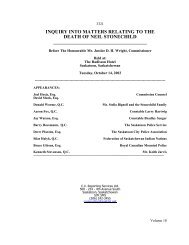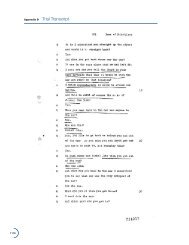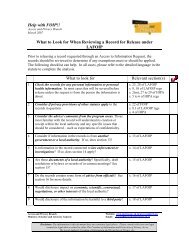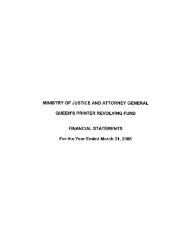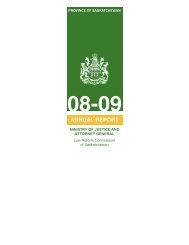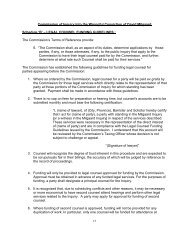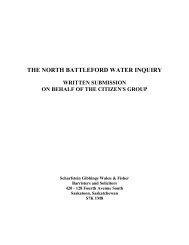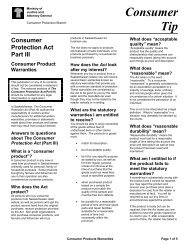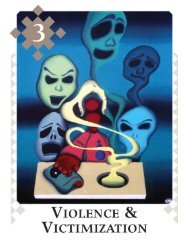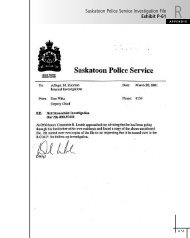Appendix K Memorandum of Law - s. 9(2) of the Canada Evidence Act
Appendix K Memorandum of Law - s. 9(2) of the Canada Evidence Act
Appendix K Memorandum of Law - s. 9(2) of the Canada Evidence Act
Create successful ePaper yourself
Turn your PDF publications into a flip-book with our unique Google optimized e-Paper software.
<strong>Appendix</strong> K <strong>Memorandum</strong> <strong>of</strong> <strong>Law</strong><br />
(b) Evidentiary Value <strong>of</strong> Inconsistent Statements Proved Under Section 9(2) <strong>of</strong> <strong>the</strong> CEA<br />
The evidentiary value <strong>of</strong> prior inconsistent statements proved under s. 9(2) <strong>of</strong> <strong>the</strong> CEA was considered<br />
by <strong>the</strong> Supreme Court <strong>of</strong> <strong>Canada</strong> in McInroy 75 . Although McInroy was decided approximately eight years<br />
after <strong>the</strong> Supreme Court <strong>of</strong> <strong>Canada</strong> dismissed David Milgaard’s application for leave to appeal, <strong>the</strong> case<br />
is considered here because it was <strong>the</strong> first Supreme Court <strong>of</strong> <strong>Canada</strong> decision to discuss <strong>the</strong> evidentiary<br />
value <strong>of</strong> prior inconsistent statements proved under s. 9(2) <strong>of</strong> <strong>the</strong> CEA and <strong>the</strong> first case containing a<br />
judgment that openly critiqued a jury’s ability to follow <strong>the</strong> limitation respecting <strong>the</strong> use <strong>of</strong> prior inconsistent<br />
statements. 76<br />
The majority <strong>of</strong> <strong>the</strong> Supreme Court in McInroy held that <strong>the</strong> value <strong>of</strong> a witness’ prior inconsistent<br />
statement under s. 9(2) <strong>of</strong> <strong>the</strong> CEA was limited to assessing <strong>the</strong> witness’ credibility. Like s. 9(1) <strong>of</strong> <strong>the</strong><br />
CEA, a prior inconsistent statement proved under s. 9(2) cannot be used as evidence <strong>of</strong> <strong>the</strong> truth <strong>of</strong> its<br />
contents unless <strong>the</strong> witness admits <strong>the</strong> truth <strong>of</strong> <strong>the</strong> statement. Where <strong>the</strong> truth <strong>of</strong> <strong>the</strong> statement is not<br />
admitted, <strong>the</strong> contents <strong>of</strong> <strong>the</strong> statement can only be used for <strong>the</strong> purpose <strong>of</strong> testing <strong>the</strong> credibility <strong>of</strong> <strong>the</strong><br />
witness.<br />
However, Justice Estey dissented on <strong>the</strong> evidentiary value <strong>of</strong> a prior inconsistent statement proved under<br />
s. 9(2) <strong>of</strong> <strong>the</strong> CEA. His judgment is skeptical <strong>of</strong> a jury’s ability to disregard <strong>the</strong> substantive contents <strong>of</strong> an<br />
inconsistent statement:<br />
… [I]n my view <strong>of</strong> s. 9 <strong>of</strong> <strong>the</strong> <strong>Canada</strong> <strong>Evidence</strong> <strong>Act</strong>, R.S.C. 1970, c. E-10, and <strong>of</strong> <strong>the</strong> common law relating to <strong>the</strong><br />
admissibility <strong>of</strong> prior inconsistent statements, <strong>the</strong> jury is entitled, and should have been so instructed here, to<br />
take into <strong>the</strong>ir consideration <strong>the</strong> contents <strong>of</strong> <strong>the</strong> prior inconsistent statement not only on <strong>the</strong> issue <strong>of</strong> determining<br />
<strong>the</strong> credibility <strong>of</strong> <strong>the</strong> witness St. Germaine, but also in determining <strong>the</strong> issues <strong>of</strong> fact arising in <strong>the</strong> trial to which<br />
<strong>the</strong> contents <strong>of</strong> <strong>the</strong> prior statement may be relevant. … It is in my respectful view both an error in law and<br />
an <strong>of</strong>fence against common sense to instruct <strong>the</strong> jury that <strong>the</strong> witness’s prior statement, particularly<br />
when given in <strong>the</strong> circumstances <strong>of</strong> this case, may be considered by <strong>the</strong> jury only on <strong>the</strong> issue as to<br />
credibility <strong>of</strong> <strong>the</strong> <strong>of</strong> <strong>the</strong> witness, St. Germaine, and must be disregarded on <strong>the</strong> issues <strong>of</strong> fact arising<br />
in this statement; and, more precisely, that <strong>the</strong> jury must be told that <strong>the</strong> prior statement may not<br />
be considered by <strong>the</strong>m as pro<strong>of</strong> or even as some evidence relating to <strong>the</strong> matters asserted in that<br />
statement.<br />
…<br />
Section 9(2) was added to <strong>the</strong> <strong>Canada</strong> <strong>Evidence</strong> <strong>Act</strong> in 1968 (1968-69, c. 14, s. 2). It comes into <strong>the</strong> <strong>Act</strong> without<br />
legislative history. The subsection has not been subjected to judicial analysis to my knowledge from <strong>the</strong> side <strong>of</strong><br />
<strong>the</strong> question raised in this appeal. The subsection, while providing a procedural mechanism for <strong>the</strong> admission<br />
<strong>of</strong> <strong>the</strong> prior contradictory statement, is silent as to <strong>the</strong> substantive use, if any, to which such evidence may be<br />
put. Taken by itself and in isolation from <strong>the</strong> judicial and academic debates <strong>of</strong> <strong>the</strong> past, <strong>the</strong> section, in my view,<br />
supports <strong>the</strong> simple interpretation that, given <strong>the</strong>ir plain meaning, <strong>the</strong> words adopted by Parliament reveal<br />
an intention that <strong>the</strong> evidence is, upon compliance with <strong>the</strong> prescribed procedure, admitted to <strong>the</strong> record for<br />
application by <strong>the</strong> tribunal in <strong>the</strong> same way as o<strong>the</strong>r evidence and without any specific limitation. 77<br />
Justice Estey goes on to cite Justice Lennox’s observations regarding a jury’s ability to disregard <strong>the</strong><br />
substantive content <strong>of</strong> a prior inconsistent statement from Duckworth and continues his critique <strong>of</strong> <strong>the</strong><br />
rule:<br />
75 McInroy, supra note 62.<br />
76 McInroy also provides guidance on <strong>the</strong> meaning <strong>of</strong> ‘inconsistency’ under s. 9(2) <strong>of</strong> <strong>the</strong> CEA. The facts <strong>of</strong> <strong>the</strong> case<br />
and <strong>the</strong> aspect <strong>of</strong> <strong>the</strong> case on <strong>the</strong> meaning <strong>of</strong> ‘inconsistency’ will be considered in detail in Part IV, section 8 <strong>of</strong> this<br />
memorandum. At this point, it suffices to say that <strong>the</strong> witness’ statements were found to be ‘inconsistent’ with her<br />
testimony at trial and she was cross-examined under s. 9(2) <strong>of</strong> <strong>the</strong> CEA.<br />
77 Emphasis added. McInroy, supra note 62 at pp. 606 and 609.<br />
2596



